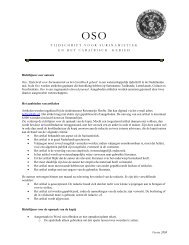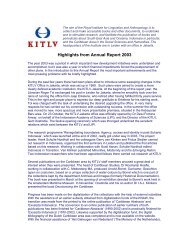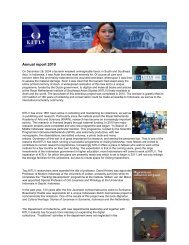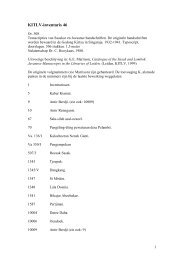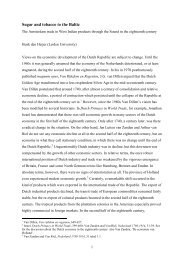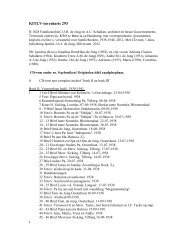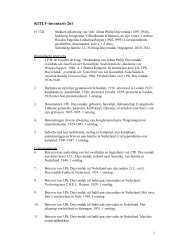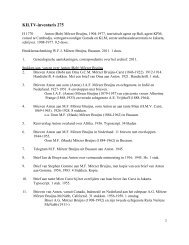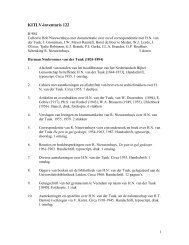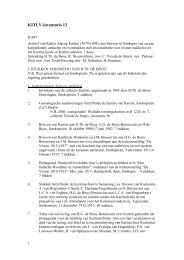Securing Land rights: Land Conflicts in Democratizing Indonesia - kitlv
Securing Land rights: Land Conflicts in Democratizing Indonesia - kitlv
Securing Land rights: Land Conflicts in Democratizing Indonesia - kitlv
Create successful ePaper yourself
Turn your PDF publications into a flip-book with our unique Google optimized e-Paper software.
<strong>Secur<strong>in</strong>g</strong> <strong>Land</strong> <strong>rights</strong>: <strong>Land</strong> <strong>Conflicts</strong> <strong>in</strong> Democratiz<strong>in</strong>g <strong>Indonesia</strong><br />
PhD project under research project From Clients to Citizens? Emerg<strong>in</strong>g Citizenship <strong>in</strong> Democratis<strong>in</strong>g <strong>Indonesia</strong>.<br />
Supervisors: Dr. Adriaan Bedner and Dr. Myrna Safitri<br />
Summary<br />
This project studies the trajectories of land conflicts over the last 15 years, ask<strong>in</strong>g how <strong>Indonesia</strong>’s<br />
democratic and legal reforms have impacted the discursive strategies, practices and capabilities of peasants<br />
and state agents to settle land conflicts. Focus<strong>in</strong>g on protracted land conflicts <strong>in</strong> Mesuji (Lampung) and<br />
Bulukumba (South Sulawesi), the projects aims to study to what extent the open<strong>in</strong>g up of new avenues for<br />
contestation after the fall of Suharto have affected the capacity of peasants to address land conflicts, and<br />
whether these developments have impact the way <strong>in</strong> which state agents implement land policies. The<br />
comparison between South Sulawesi and Lampung serves to ascerta<strong>in</strong> to what extent local conditions –<br />
particularly the nature of available trust networks and the regulatory capacity of the state – have impacted<br />
the trajectories of these land conflicts.<br />
General Description<br />
How states determ<strong>in</strong>e and guarantee access to natural resources for their subjects and how these subjects<br />
champion their claims to natural resources offers important <strong>in</strong>sights <strong>in</strong>to ‘the state of citizenship’ (Holston<br />
2009). This certa<strong>in</strong>ly applies to <strong>Indonesia</strong>,where the state is still struggl<strong>in</strong>g to come to terms with the<br />
consequences of the decision after <strong>in</strong>dependence to radically break with the colonial past and move from an<br />
adat-based system to a national system of land <strong>rights</strong> (Fitzpatrick 1997, Peluso 2001). While the Basic<br />
Agrarian Law of 1960 paid lip service to adat, it was clear that this statute attempted to actually get rid of the<br />
recognition of collective adat <strong>rights</strong> and to replace <strong>in</strong>dividual adat <strong>rights</strong> with a uniform system (Bedner &<br />
Van Huis 2010). This move was supported by the attempts of legal scholars such as Koesnoe to keep on board<br />
the legitimis<strong>in</strong>g force of adat, <strong>in</strong> transform<strong>in</strong>g it from a locally entrenched and developed system <strong>in</strong>to a<br />
national adat (Burns 2004).<br />
If we look at the Basic Agrarian Law <strong>in</strong> retrospect, we can hardly imag<strong>in</strong>e that its drafters seriously<br />
thought that the radical transformation programme they presented could possibly work out, both because the<br />
state lacked the capacity to carry out the necessary steps of registration and redistribution and because of the<br />
resistance to be expected aga<strong>in</strong>st such changes from adat communities all over <strong>Indonesia</strong> (Lucas & Warren<br />
2003). Similarly, replacement of local by national adat through judicial precedent – a famous example be<strong>in</strong>g<br />
<strong>rights</strong> to land of female Karo Batak – was contested (Pompe 2005). However, where the latter concerned<br />
<strong>in</strong>dividual cases and was by its nature piecemeal-oriented, the legislative change created differences between<br />
law and local norms which where almost impossible to bridge. In other words, the national citizenship<br />
programme of the government was too far removed from the allegiance at lower level to adat notions of<br />
citizenship.<br />
The consequences of the <strong>in</strong>troduction were far-reach<strong>in</strong>g. First, through the construction of ‘state land<br />
(tanah negara) <strong>in</strong> comb<strong>in</strong>ation with the difficulty of prov<strong>in</strong>g the existence of collective <strong>rights</strong>, the national<br />
government acquired powers <strong>in</strong> usurp<strong>in</strong>g land that stretched even beyond those the colonial government<br />
enjoyed on the basis of the Doma<strong>in</strong> Declaration (Parl<strong>in</strong>dungan 1998, Bedner 2001). Secondly, by creat<strong>in</strong>g a<br />
system of land adm<strong>in</strong>istration that required registration and by declar<strong>in</strong>g no longer acceptable the practice<br />
carried over from colonial times to accept tax receipts as evidence of property, the legislator pulled the rug<br />
from under a system of gradual transformation from a ‘cultural’/ethnic model of property <strong>rights</strong> to a national<br />
system. It is not difficult to see why the New Order ma<strong>in</strong>ta<strong>in</strong>ed this system, as it perfectly served the regime<br />
to implement its policies of exploitation. The power of the state over natural resources – as laid down <strong>in</strong>
Article 33 of the Constitution – was further re<strong>in</strong>forced by the extension of the area marked as ‘forest’, which<br />
legally speak<strong>in</strong>g pushed millions of people out of their livelihoods (McCarthy 2006).<br />
Contemporary economic developments <strong>in</strong> comb<strong>in</strong>ation with rapid population growth have seriously<br />
complicated this situation. While dur<strong>in</strong>g the New Order outside Java and Madura the logg<strong>in</strong>g boom was<br />
probably the ma<strong>in</strong> driver of grow<strong>in</strong>g land scarcity, now the timber <strong>in</strong>dustry has been replaced by oil palm and<br />
to a lesser extent other cash crops such as cocoa. While the overall effects are still be<strong>in</strong>g debated, it seems that<br />
<strong>in</strong> some places the oil palm leads to new opportunities for local populations, but <strong>in</strong> others it has led to<br />
extensive dispossession and poverty (McCarthy 2010, Li 2010). An important f<strong>in</strong>d<strong>in</strong>g is also that it has led to<br />
stratification with<strong>in</strong> villages to a degree hitherto unknown.<br />
All of this does not proceed <strong>in</strong> a smooth manner, because many peasants do not meekly accept the<br />
new situation. The first years of reformasi saw active campaign<strong>in</strong>g by local peasants and legal aid<br />
organizations to annull the land-concessions to big plantation companies that were handed out dur<strong>in</strong>g the<br />
New Order (Fuller-Coll<strong>in</strong>s 2007) This open<strong>in</strong>g up of possibilities for democratic protest has led to a boom <strong>in</strong><br />
land conflicts, 1 which are extremely hard to resolve because of the defects <strong>in</strong> the legal construction of <strong>rights</strong><br />
to land and a transition to a modern society where adat no longer has the ‘natural’ position it used to have<br />
(McWilliam 2006). We are thus faced with the consequences of the ‘law as a programme’ approach (Allott<br />
1980; Noer Fauzi Rachman 1999) adopted by the <strong>Indonesia</strong>n state when it enacted the BAL, as well as as of<br />
40 years of emasculation of the judiciary (Pompe 2005) – the latter <strong>in</strong>stitution now <strong>in</strong> the process of be<strong>in</strong>g<br />
rebuilt, but at a slow pace.<br />
Research on these land conflicts suggests that <strong>Indonesia</strong>’s democratization process is open<strong>in</strong>g up<br />
new avenues for local peasants to secure control over land: local (ethnic) organizations are <strong>in</strong>creas<strong>in</strong>gly<br />
<strong>in</strong>vok<strong>in</strong>g adat to strengthen their claim over land (Henley and Davidson 2008), while the new class of locally<br />
elected politicians are also regularly sought after support land claims (Bakker 2009). The rise of new NGOs,<br />
the strengthen<strong>in</strong>g of their l<strong>in</strong>ks with national level NGOs and the <strong>in</strong>crease <strong>in</strong> freedom of the press have<br />
furthermore turned many local conflicts <strong>in</strong>to national ones, draw<strong>in</strong>g the attention from both the government<br />
and political parties, as well as from ‘guardian <strong>in</strong>stitutions’ such as the National Human Rights commission<br />
and the Ombudsman. The <strong>in</strong>creased possibility for many to access a diversity of actors who may help them to<br />
support or resolve their cause has led to new constellations of power at all levels. At first glance this looks<br />
similar to the <strong>in</strong>surgence of democratic citizenship <strong>in</strong> the urban peripheries <strong>in</strong> São Paulo, Brazil, where the<br />
society def<strong>in</strong>es its ‘own’ citizenship <strong>in</strong> opposition to that of the state (Holston 2009). However, it seems that<br />
<strong>in</strong> the end <strong>Indonesia</strong>n communities rather phrase their compla<strong>in</strong>ts <strong>in</strong> terms of the system and do not situate<br />
themselves outside of it.<br />
Specific Objective(s)<br />
This sub-project proposes to look at the trajectories of a selection of serious land conflicts about agrarian land<br />
use change. Its objective is to contribute to a history of the struggle for land <strong>rights</strong> <strong>in</strong> <strong>Indonesia</strong> over the last<br />
15 years, with a focus on how <strong>Indonesia</strong>’s reforms towards democracy and the rule of law have impacted the<br />
strategies, practices and capabilities of peasants and their organisations <strong>in</strong>volved <strong>in</strong> land conflict:s, as well as<br />
the responses of the state agents <strong>in</strong>volved.<br />
The research will exam<strong>in</strong>e discursive strategies, compar<strong>in</strong>g the use of ‘adat’ arguments <strong>in</strong> selected<br />
land conflicts to more ‘<strong>in</strong>surgent forms of citizenship’. It will further exam<strong>in</strong>e whether more traditional<br />
conceptions of land <strong>rights</strong> (<strong>in</strong>clud<strong>in</strong>g, but not limited to, adat) are translated with<strong>in</strong> such a citizenship based<br />
1 Of course the New Order saw the occurrence of many land conflicts as well: Human <strong>rights</strong>’ NGO ELSAM, has<br />
reported 1.497 cases dur<strong>in</strong>g that period (Aritonang 2004).
ights framework (cf. Henley and Davidson 2008) - i.e. argued <strong>in</strong> terms of the Basic Agrarian Law and other<br />
laws <strong>in</strong>volved (the Forestry Law, the M<strong>in</strong><strong>in</strong>g Law, the Plantation Law, etc), but also an <strong>in</strong>ternationally<br />
oriented human <strong>rights</strong> framework - or whether those <strong>in</strong>volved <strong>in</strong> such conflicts opt for other strategies based<br />
on clientelistic or other structures that can be considered as alternatives to liberal citizenship. This <strong>in</strong>cludes<br />
not only an evaluation of the policies of spatial/development plann<strong>in</strong>g, but also legal <strong>in</strong>terpretations by the<br />
judiciary. In so do<strong>in</strong>g the research will directly contribute to unearth the relations between political<br />
mediation and access<strong>in</strong>g <strong>rights</strong>.<br />
A second major concern is to assess <strong>in</strong> what ways the changed ‘political opportunity structure’(Tilly<br />
and Tarrow 2006) has affected the mobilization strategies of actors <strong>in</strong>volved <strong>in</strong> conflicts over land. Given the<br />
overarch<strong>in</strong>g theme of the project we are particularly <strong>in</strong>terested to see whether the practice of secur<strong>in</strong>g<br />
control over land through clientelistic exchanges is giv<strong>in</strong>g way to forms of <strong>rights</strong>-based collective action.<br />
This leads us to the follow<strong>in</strong>g research-questions:<br />
1) What are the serious land conflicts <strong>in</strong>volv<strong>in</strong>g dispossession that have emerged <strong>in</strong> Lampung and South<br />
Sulawesi, how and why have they started and evolved s<strong>in</strong>ce?<br />
2) What has been the impact of <strong>Indonesia</strong>’s legal and <strong>in</strong>stitutional reforms on the capacities of peasants<br />
to actualize land <strong>rights</strong>: have <strong>in</strong>creased civil liberties affected the mobilization capacities of peasant<br />
groups?<br />
3) What strategies have the disputants followed, which choices have they made <strong>in</strong> the pursuit of their<br />
objectives and why have they made these choices?<br />
4) What are the outcomes of these strategies, how can they be expla<strong>in</strong>ed and what do they mean for the<br />
notions of citizenship and rule of law of those <strong>in</strong>volved?<br />
5) What can we learn from this about the current <strong>Indonesia</strong>n legal-<strong>in</strong>stitutional framework for land<br />
governance and how it might be improved?<br />
Workplan<br />
To answer the research questions, this project will trace the history of recent land conflicts <strong>in</strong> Mesuji<br />
(Lampung) and Bulukumba (South Sulawesi). Through a comb<strong>in</strong>ation of ethnographic fieldwork on current<br />
activism for land <strong>rights</strong> and <strong>in</strong>terviews with actors <strong>in</strong>volved <strong>in</strong> the struggles, this project will capture the<br />
evolution of strategies, practices and capacities of local land-<strong>rights</strong> movement dur<strong>in</strong>g <strong>Indonesia</strong>’s<br />
democratization process.<br />
We will furthermore exam<strong>in</strong>e the legal aspects of these cases. This serves to establish a k<strong>in</strong>d of<br />
yardstick to evaluate to what extent the arguments made by both sides are actually supported by law.<br />
Furthermore, we will look how these national legal rules filter down to the level of local state agents’ policies<br />
and practices and thus exam<strong>in</strong>e whether and if so how they take new shapes (cf. Moelionio 2011).<br />
The comparison between Lampung and South Sulawesi serves to ascerta<strong>in</strong> the conditions facilitat<strong>in</strong>g or<br />
h<strong>in</strong>der<strong>in</strong>g the capacity of land-<strong>rights</strong> movements to realise land <strong>rights</strong>. In the l<strong>in</strong>e of the general research<br />
proposal, the comparisons will focus particularly on the nature of local trust networks and l<strong>in</strong>kages to higher
levels through NGOs and other organisations facilitat<strong>in</strong>g them. We will also compare the regulatory capacity<br />
of the local state and how it is politically embedded.<br />
Both Lampung and South Sulawesi have seen serious land conflicts as a consequence of<br />
dispossession and the development of plantations (S. Rahma Mary H. and Noer Fauzi Rachman 2011;<br />
Muannas 2003). They typically <strong>in</strong>volve a state owned corporation, or a corporation supported by the<br />
government, aga<strong>in</strong>st local residents. The role of an adat community <strong>in</strong> the land conflicts can also be identified<br />
<strong>in</strong> both places: the Megou Pak community <strong>in</strong> Lampung and the Kajang community <strong>in</strong> South Sulawesi. Some of<br />
these conflicts have led to serious violence result<strong>in</strong>g <strong>in</strong> several casualties and allegations of human <strong>rights</strong><br />
abuses. At the end of 2011 a video was circulated on the <strong>in</strong>ternet, show<strong>in</strong>g horrific acts of violence allegedly<br />
hav<strong>in</strong>g taken place <strong>in</strong> Mesuji (Lampung), lead<strong>in</strong>g the central government to form a fact f<strong>in</strong>d<strong>in</strong>g team. A similar<br />
case occurred<strong>in</strong> Bulukumba (South-Sulawesi).The landconflict between the corporation and the Kajang<br />
community, which took three lives <strong>in</strong> an <strong>in</strong>cident <strong>in</strong> 2003, has rema<strong>in</strong>ed unresolved to this moment.<br />
Scientific Relevance<br />
While the struggle for land <strong>rights</strong> <strong>in</strong> <strong>Indonesia</strong> has received considerable attention (see for example Fuller<br />
Coll<strong>in</strong>s 2007, McCarthy 2006, Li 2010, Lucas and Warren 2003), this project will add to this literature by (a)<br />
<strong>in</strong>terpret<strong>in</strong>g the chang<strong>in</strong>g nature of the structure for land <strong>rights</strong> <strong>in</strong> the light of chang<strong>in</strong>g forms of citizenship <strong>in</strong><br />
<strong>Indonesia</strong> and (b) its attention for regional comparisons and variation between different prov<strong>in</strong>ces.<br />
Time table of the project and Milestones<br />
Sept 2012-may 2013<br />
Jan 2013<br />
Jan 2013 –<br />
Dec 2013 – May 2015<br />
June 2015 – Jan 2017<br />
Selection and preparatory phase for Dikti scholarships<br />
Start of the Project<br />
Nov 2013 Preparation<br />
Fieldwork <strong>in</strong> <strong>Indonesia</strong>, alternat<strong>in</strong>g between Lampung and South Sulawesi<br />
Writ<strong>in</strong>g of PhD thesis, writ<strong>in</strong>g of peer-reviewed academic article, contribution to<br />
edited volume.<br />
Research locations<br />
Lampung and South-Sulawesi<br />
Literature references<br />
Allott, A. (1980). The Limits of Law, London: Butterworths.<br />
Aritonang, E. (2004). Potret Penyiksaan dalam Konflik Agraria di <strong>Indonesia</strong>. Occasional Paper Series #2,<br />
Elsam, Jakarta. Retrieved March 1, 2012, from<br />
http://www.elsam.or.id/downloads/1296553274_Potret_Penyiksaan_dalam_Konfik_Agraria-<br />
Occasional_Paper.pdf
Bedner, A. W. (2001). Adm<strong>in</strong>istrative Courts <strong>in</strong> <strong>Indonesia</strong>: A Social Legal Study, The Hague, London & Boston:<br />
Kluwer Law International.<br />
Bedner, A.W. and J. Vel (2010) ‘An Analytical Framework for Empirical Research on Access to Justice’, Law,<br />
Social Justice & Global Development Journal, 1-29. http://www.go.warwick.ac.uk/elj/lgd/20010_1/bedner_vel<br />
Burns, P. (2004). The Leiden Legacy: Concepts of Law <strong>in</strong> <strong>Indonesia</strong>. Leiden: KITLV Press.<br />
Butt, S. (2007) "Judicial review <strong>in</strong> <strong>Indonesia</strong>: between civil law and accountability? A study of constitutional<br />
court decisions 2003-2005"<br />
Fauzi, Noer (1999) Petani dan Penguasa: D<strong>in</strong>amika Perjalanan Politik Agraria. <strong>Indonesia</strong>, Yogyakarta: Insist<br />
Press, KPA and Pustaka Pelajar.<br />
Fitzpatrick, D. (1997). “Disputes and Pluralism <strong>in</strong> Modern <strong>Indonesia</strong>n <strong>Land</strong> Law.” The Yale Journal of<br />
International Law, 22(1), 171-212.<br />
Henley, D. and J. Davidson (2008) “In the Name of Adat: Regional Perspectives on Reform, Tradition, and<br />
Democracy <strong>in</strong> <strong>Indonesia</strong>”, Modern Asian Studies, 815-852.<br />
Holston, J. (2009), “Insurgent Citizenship <strong>in</strong> an Era of Global Urban Peripheries”. City & Society, 21: 245–267.<br />
Li, Tania (2009) ‘To Make Live or Let Die? Rural Dispossession and the Protection of Surplus Populations’,<br />
Antipode 41(S1): 66-93.<br />
Lucas, A. & Warren, C. (2003). “The State, the People, and Their Mediators: The Struggle over Agrarian Law<br />
Reform <strong>in</strong> Post New Order <strong>Indonesia</strong>.” <strong>Indonesia</strong>, 76, 87-126.<br />
Mary, S. Rahma and Noer Fauzi Rahman. (2011). “Mesuji, Cerm<strong>in</strong> Konflik Agraria yang<br />
Kronis”.RetrievedMarch 1, 2012, fromwww.kpa.or.id/?p=636.<br />
McCarthy, J.F. (2006). The Fourth Circle : Institutional Arrangements on Sumatra’s Ra<strong>in</strong>forest Frontier.<br />
Stanford: Stanford University Press.<br />
McCarthy, J.F. (2010). “Processes of Inclusion and Adverse Incorporation: Oil Palm and Agrarian Change <strong>in</strong><br />
Sumatra, <strong>Indonesia</strong>.” Journal of Peasant Studies, 37(4), 821-850.<br />
McWilliam, A. (2006). “Historical Reflections on Customary <strong>Land</strong> Rights <strong>in</strong> <strong>Indonesia</strong>. Asia Pacific Journal of<br />
Anthropology, 7(1), 45-64.<br />
Moeliono, T. (2011). “Spatial Management <strong>in</strong> <strong>Indonesia</strong>: From Plann<strong>in</strong>g to Implementation, Cases from West<br />
Java and Bandung. A Socio-legal Study”, PhD-thesis, Leiden: LeidenUniversity.<br />
Muannas, T.L. (2003). “Kajang, Perlawanan Tak Berujung”. Majalah Tempo Onl<strong>in</strong>e, 04-08-2003. Retrieved<br />
March 1, 2012,<br />
fromhttp://majalah.tempo<strong>in</strong>teraktif.com/id/arsip/2003/08/04/NAS/mbm.20030804.NAS89487.id.html<br />
Parl<strong>in</strong>dungan, A.P. (1998). Komentar atas Undang-Undang Pokok Agraria, Dilengkapi PPNo. 40 dan 41, Tahun<br />
1996. Bandung: Mandar Maju.<br />
Pompe, S. (2005). The <strong>Indonesia</strong>n Supreme Court: A Study of Institutional Collapse. Ithaca, N.Y.: Cornell<br />
University, Southeast Asia Program.
Tilly, C. and S. Tarrow (2006) Contentious Politics. Paradigm Publishers.




